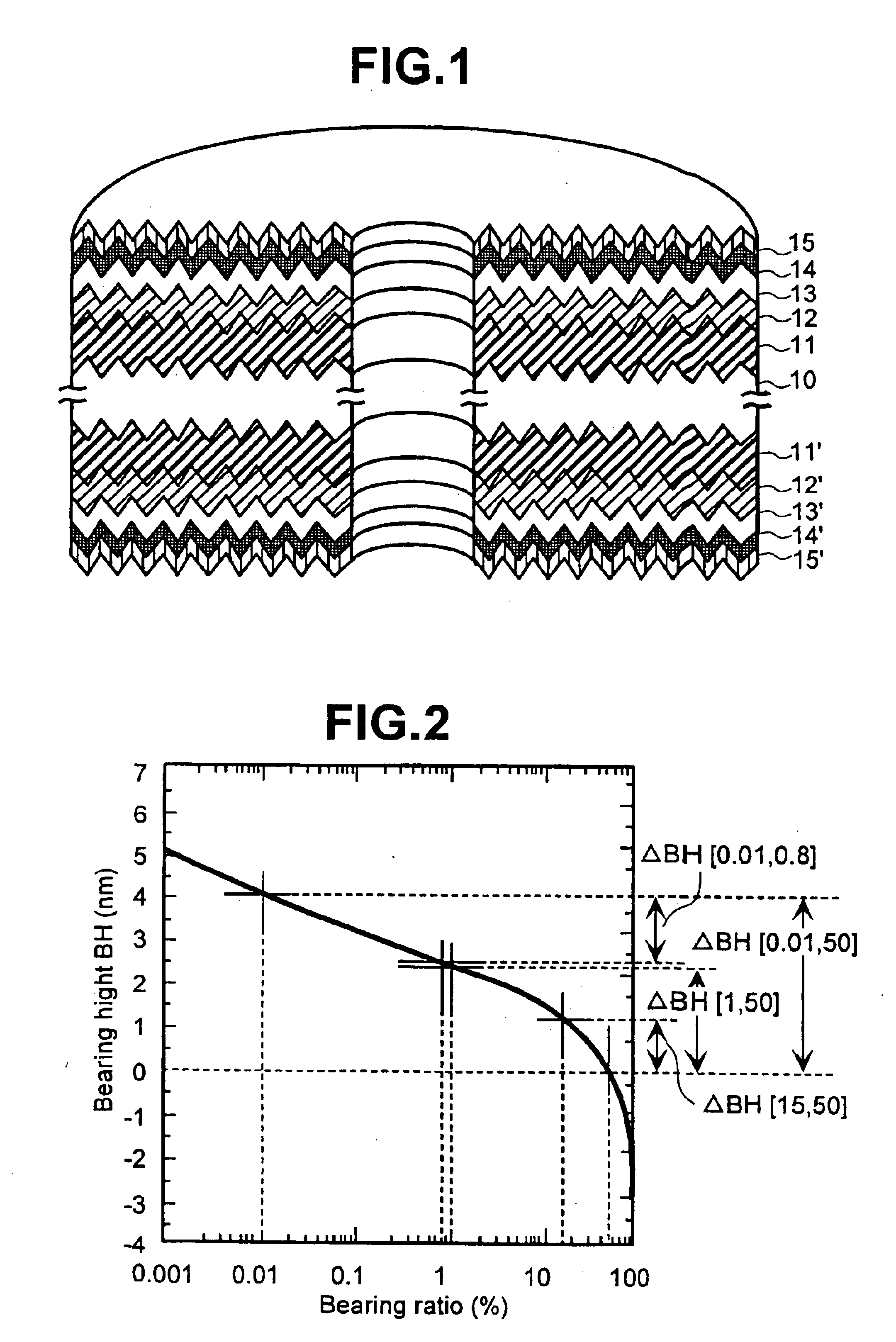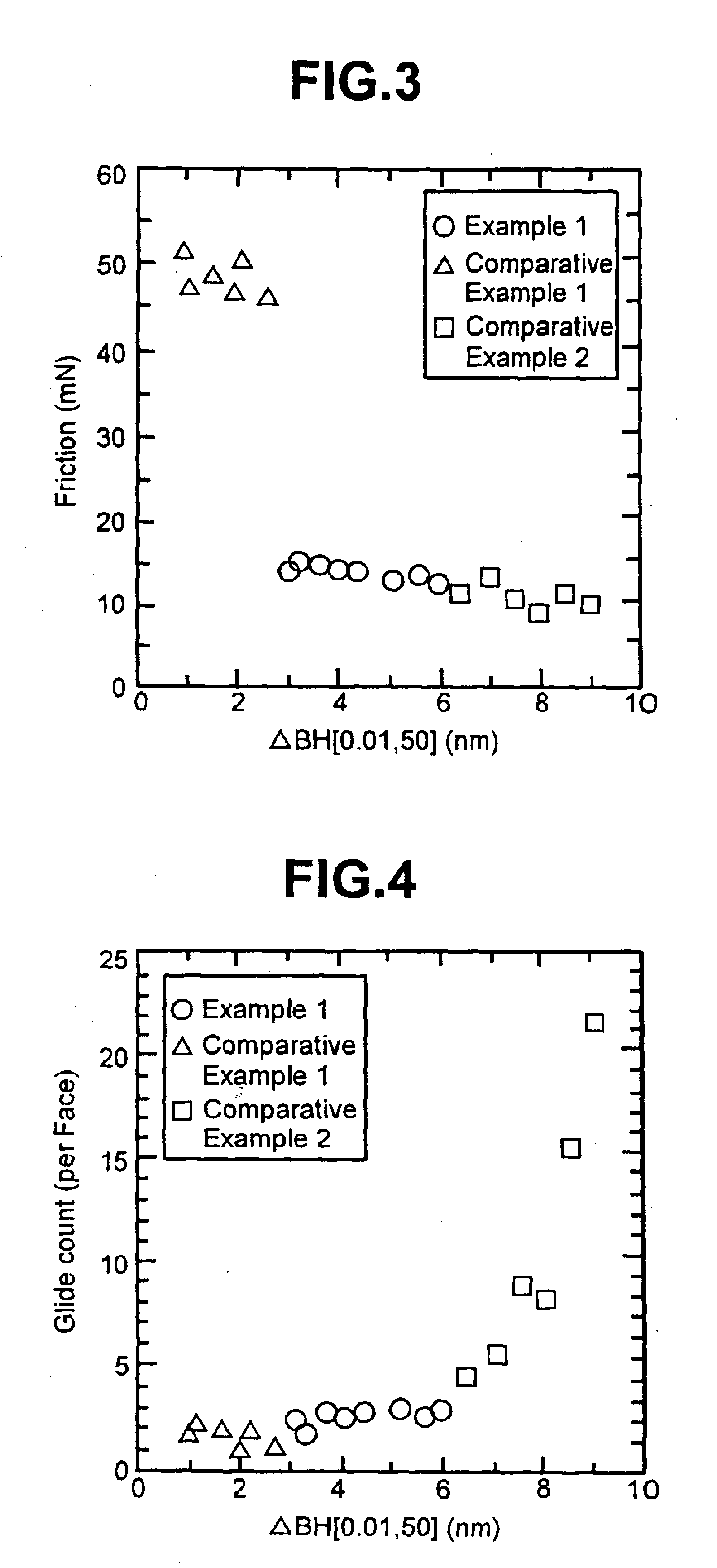Magnetic recording media and magnetic disk apparatus
a magnetic disk and recording media technology, applied in the field of magnetic disk apparatuses and recording media, can solve the problems that the head and the media interface is becoming difficult to prevent the head from contact, and achieve the effects of reducing the possibility of a crash of the magnetic head to said projection, high recording density, and small energy at a crash
- Summary
- Abstract
- Description
- Claims
- Application Information
AI Technical Summary
Benefits of technology
Problems solved by technology
Method used
Image
Examples
embodiment 1
[Embodiment 1]
FIG. 1 is a drawing to illustrate a cross section of an embodiment of magnetic recording media of the present invention. A disk substrate of 0.635 thick and 2.5 inches type of Almino-silicate glass with the surface chemically tempered was used as a substrate 10. It was formed with multi-layer films, as follows, on the surface by using a static magnetron sputtering system (MDP250B) made by Intevac after cleaned up. First, the first under layers 11 and 11′ of 40 nm thickness composed of alloy with 65 at. % of Ni, 20 at. % of Cr and 15 at. % of Zr were formed on both sides of the surface of a substrate 10. Thereafter, it was heated up to about 230 deg. C. on the substrate using a lamp heater, and exposed in an environment of mixed gas of 5 mTorr pressure with 99% of Ar and 1% of O2 during 3.5 seconds. Then the second layers 12 and 12′ of 30 nm thickness composed of alloy with 80 at. % of Cr and 20 at. % of Ti were formed, magnetic layers 13 and 13′ of 20 nm thickness comp...
comparing example 1
[Comparing Example 1]
In this comparing example 1, the magnetic recording media was made under the same condition as the embodiment 1 described above except that Δ BH[0.01, 50] of media surface was from 1 nm to 2.6 nm.
The relation between the friction force and Δ BH[0.01, 50] of the media of present comparing example is plotted in FIG. 3. The friction force of the media in the present comparing example is from 46 mN to 52 mN, while the friction force was from 12 mN to 15 mN in case of the media in the embodiment 1. This means not only degradation of reliability but also impossibility of stable recording / reproducing. Therefore, it is difficult to achieve so high recording density as 11 gigabits per square inch or more in case of the present comparing example.
comparing example 2
[Comparing Example 2]
In this comparing example 2, the magnetic recording media was made under the same condition as the embodiment 1 described above except that Δ BH[0.01, 50] of media surface was from 6.3 nm to 9.1 nm.
As shown in FIG. 3, the friction force in comparing example 2 is from 8 mN to 13 mN, which is equivalent to the embodiment 1 or less. Therefore, there is little problem happened of wear reliability and stable recording / reproducing characteristics. However, as shown by FIG. 4, glide count is increased rapidly in accordance with Δ BH[0.01, 50] being larger. This means that the possibility of head crash is high and there is problem of wear reliability. Therefore, it is difficult to achieve so high recording density as 11 gigabits per square inch or more in case of the present comparing example.
PUM
 Login to View More
Login to View More Abstract
Description
Claims
Application Information
 Login to View More
Login to View More - R&D
- Intellectual Property
- Life Sciences
- Materials
- Tech Scout
- Unparalleled Data Quality
- Higher Quality Content
- 60% Fewer Hallucinations
Browse by: Latest US Patents, China's latest patents, Technical Efficacy Thesaurus, Application Domain, Technology Topic, Popular Technical Reports.
© 2025 PatSnap. All rights reserved.Legal|Privacy policy|Modern Slavery Act Transparency Statement|Sitemap|About US| Contact US: help@patsnap.com



